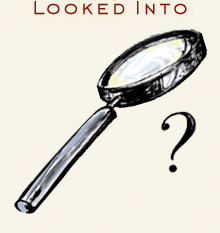Emdashes—Modern Times Between the Lines
The Basics:
About Emdashes | Email us
Ask the Librarians
Best of Emdashes: Hit Parade
A Web Comic: The Wavy Rule
Features & Columns:
Headline Shooter
On the Spot
Looked Into
Sempé Fi: Cover Art
The Wavy Rule, a Daily Comic by Pollux: Thrifty's Syndrome
Filed under: The Wavy Rule Tagged: cartoons, comics, linguistics, neurology, Pollux, The Wavy Rule, words

Click on the image for a detailed view! (continued)
Brief Interviews With Beautiful Designers
Filed under: Clips Tagged: 20 Under 30, art, Brian Collins, Cat Power, Christian Cervantes, design, Eleanor Grosch, illustration, Kate & Camilla, New Visual Artists, Print, Zigmunds Lapsa
Profiles from Print magazine’s annual New Visual Artists issue (“20 Under 30”), 2007, 2008, and 2009:
It’s not every 29-year-old who inspires this kind of naked emotion in his boss: “I’m deeply, and unforgivably, envious.” That’s the chief creative officer of Ogilvy & Mather’s Brand Innovation Group, Brian Collins, talking about new kid Christian Cervantes. As his dramatic name suggests, the designer has an impossible dream: to reawaken brands as familiar to us as our own faces.
Take, for instance, Coke. Cervantes forged a radical new campaign for Coke Zero, which is marketed to young men. “The word ‘masculine’ brought up images of dudes bro-ing out over ‘chicks’ and football,” he groans. “I wanted to do something a lot more subtle but still powerful.” He commissioned the British studio iLovedust to help create an iconography of playfully masculine illustrations (“exploding fire hydrants, sensual lips, predatory animals and their prey …”), adding silhouettes of snowcaps and ice fishermen to provide the necessary chill. “I had so much fun creating these little worlds within worlds,” he says, and notes that the freedom the creative directors afforded him made all the difference. Continued.
Groucho Marx sang the praises of famous pairs: “Boy meets girl. Romeo and Juliet. Minneapolis and St. Paul.” Add to the list Kate and Camilla, a team of photographers who shared a camera one semester at Smith College and never put it (or each other) down. They do fashion shoots, but sometimes there are no people in them—just empty pants and boots, lounging in a field. They do portraits—of the manicurist Joe Shepard, forexample—but where his head should be, there’s the grave, iridescent-scaled face of a red snapper, held up like a commedia dell’arte mask. The people in Kate and Camilla’s work have texture, combination skin, complex lives, sweat, and occasional drips of fish blood.
Perhaps because of the photographers’ oft-stated willingness to photograph “anything” (which has come in handy for their Nerve.com blog), remarkable people tend to seek them out. One such figure is the singer Chan Marshall, known as Cat Power, whom they shot provocatively sporting a plastic tiger mask for Venus magazine. Kate says that part of what made the shoot so fun was that “the three of us—myself, Camilla, and Chan—were given free rein.” Matador spokesman Nils Bernstein knew they’d ace it: “I’ve seen them compared to Inez van Lamsweerde and Vinoodh Matadin, which I can see, but Kate and Camilla’s work doesn’t always have that icy perfection. They seem to love the tiny flaws and behavioral quirks that make people beautiful.” Along the same lines, Caroline Priebe, founder and designer of Uluru (a clothing line they’ve also shot for), calls their photos “striking, shiny, crisp, intimate, sexy, and almost edible.” Continued.
So many animals end up in the Eleanor Grosch universe—on the pillows, rock posters, and Keds where her designs appear, for instance—that a Dr. Dolittle comparison wouldn’t be off base. In fact, she named her Philadelphia studio, Pushmepullyou, after the creature with a head at each end from the classic children’s book.
Such an animal also suggests Grosch’s harmonious opposites: commercial design with a strong commitment to the environment; freelance freedom and fiscal sense; pop culture and classical influences. Grosch walks a cheerfully nonchalant line between cute and cool, using a relatively limited palette and a menagerie of whimsical imagery. Creatures have always been an integral part of her life, beginning with her earliest memories of the Lowry Park Zoo in her hometown of Tampa. “I was absolutely in love with birds when I was small. Going to the aviary was like heaven for me!” she exclaims. “The roseate spoonbill, snowy egret, and grey heron were all pretty common sights.” Continued.
Zigmunds Lapsa isn’t easily fazed. He grew up in Riga, the capital of Latvia, which he describes as a “country with 2.3 million people and 5.4 graphic designers at that time.” After two years in an unstimulating local design program, he decided that what he needed was more hands-on experience, a bit of which he’d gained through working for ad agencies to pay his expenses.
Hence, a leap: to London’s Central Saint Martins College of Art and Design, where Lapsa studied design and typography and found himself. He threw himself into real-world work with the British designer Bobby Gunthorpe, who praises Lapsa’s originality and says, “He would be embarrassed for me to say it, but he truly was an inspiration to his classmates.” Humble, hardworking, and handsome, too? “The fact he looks like a young Harrison Ford can’t hurt,” Gunthorpe says. Next, Lapsa returned to Riga to work for an interactive studio called Hungry Lab. The multiple logos and layered patterns he created for its identity mirror the studio’s penchant for surprise and experimentation. Continued. (continued)
I'll Sing You Five-O, Green Grow the Rushes-O!
Filed under: Personal Tagged: Benjamin Chambers, Carolita Johnson, David Remnick, Donald Antrim, Erin Overbey, Harold Ross, Jesse Ewing, Jon Michaud, Jonathan Taylor, Martin Schneider, Patric King, Pollux, Rea Irvin, Su
Five years ago today, I sat in the appropriately named Williamsburg bar The Lucky Cat (now Bruar Falls), enjoying tea and free wifi, and began this blog. One was far from a lonely number; from the beginning, Emdashes had friends, commenters (though as a readership, dear readership, you tend to be shy, preferring to send me thoughtfully composed emails rather than shout to the public square), supporters, and exactly one member of the peanut gallery, whose small legumes haven’t scarred.
But Emdashes today is a lot more than a gal in a bar feeling warm toward a heartbreakingly flawless Donald Antrim essay. It’s an honest-to-Irvin team, a clan of kindred spirits, a gathering place for like-minded New Yorker-philes for whom a casual read and a quick look will never be enough. It’s the blog’s core group of friends and collaborators, Martin Schneider and Pollux and Jonathan Taylor and Benjamin Chambers, about whom I can’t say enough, and I hope they know how thoroughly I treasure their winsome and steady posts, essential ideas, and intercontinental companionship. It’s the many excellent guest writers and artists, and smart and generous interns, who’ve contributed to the blog over the past five years.
I’m almost too emotional to write this, and it’s almost New Year’s Eve, so, for once, I’m at a loss for words. What can I say but thank you, thank you, thank you, thank you, thank you? To Patric King and Su from House of Pretty, illustrators Jesse Ewing and (righteously lupine) Carolita Johnson, and the New Yorker librarians, Jon Michaud and Erin Overbey, whose clever minds are only outdone by their open hearts, and who have taken their fabulous Emdashes Ask the Librarians column all the way to The Big Show. To David Remnick and the New Yorker staff, from 1925 on out, for being there week in and week out, in the best and worst of times—proving that the life of the mind, the world of the page, and the shimmering pixels of the screen can be noble, beautiful, truthful, and funny causes to which to dedicate oneself. To you, reader. Stay with us; we’ll be here. (continued)
The Wavy Rule, a Daily Comic by Pollux: Old Year's Night
Filed under: The Wavy Rule Tagged: cartoons, comics, Condé Nast Building, Dorothy Parker, New Year's, Pollux, The Wavy Rule

Click on the image for a detailed view! (continued)
Happy Birthday to Emdashes!
Filed under: Little Words Tagged: Benjamin Chambers, Claude Smith, Mad Men
Benjamin Chambers writes:
Emily says today is Emdashes’ fifth anniversary. In celebration, I offer the following cartoon by Claude Smith, from the June 24, 1967 issue of our favorite magazine. I like to think the group is looking at an early mock-up of this blog. (Click for larger view.)
P.S. You can also consider it an entry in Martin’s series of Mad Men Files columns. (continued)
The Big Plenty: An End-of-Year Message
Filed under: Personal Tagged: anniversaries, E.B. White, Harold Ross, Katherine White, New Year's, Paul Krugman, Pollux, Rea Irvin
Pollux writes:
For the economist Paul Krugman, the years 2000 to 2009 may have been The Big Zero, but for me, thanks to Emdashes, the last couple of years have been an Era of Plenty. I mean the kind of “Plenty” that matters, the kind that is less about material acquisition and more about gaining access to new thoughts and ideas. (continued)
Lorrie Moore's Latest Novel: Alternate Covers, New Yorker-Style
Filed under: Looked Into Tagged: books, Daniel Hertzberg, design, fiction, Lorrie Moore, Peter Terzian

Emily Gordon writes:
Our friend and Print contributing editor Peter Terzian showcases some of the unused covers for Moore’s novel A Gate at the Stairs (which I reviewed not long ago). And there’s a double New Yorker connection! Peter writes:Barbara de Wilde, associate art director at Alfred A. Knopf, has designed the jackets of Lorrie Moore’s novels and story collections dating back to Like Life, in 1990. For the cover of A Gate at the Stairs, Moore’s first book in a decade, de Wilde initially contacted Daniel Hertzberg, whose illustrations she had seen in The New Yorker. “I loved the high-contrast quality of his drawings,” she says. “It reminded me of Robert McCloskey books. I wanted all those remarkable colors from Blueberries for Sal and Make Way for Ducklings—those mustards and odd greens and quirky blues.”Go to the post to see the parallel-universe covers! (continued)
The Wavy Rule, a Daily Comic by Pollux: Road Rage
Filed under: The Wavy Rule Tagged: bicycles, cars, cartoons, comics, Pollux, The Wavy Rule

Click on the image for a detailed view! (continued)

Martin Schneider writes:
Some people, you figure they will just always be there. David Levine was drawing caricatures for The New York Review of Books well before my birth, and it was only reasonable to suppose he'd be at it years after my death, too. It's difficult to imagine a world without a steady succession of new Levine drawings in it; it's not merely perverse fancy to wonder whether Levine's death makes it impossible for The New York Review of Books to keep publishing articles. That is how strong that association was.
You may have guessed that I grew up in a household with The New York Review of Books in it. Has there ever been a connection between an illustrator and a periodical as (continued)
The Wavy Rule, a Daily Comic by Pollux: Cardinal Numbers
Filed under: The Wavy Rule Tagged: birds, cardinal, cartoons, comics, insurance, Pollux, The Wavy Rule

Click on the image for a detailed view! (continued)












